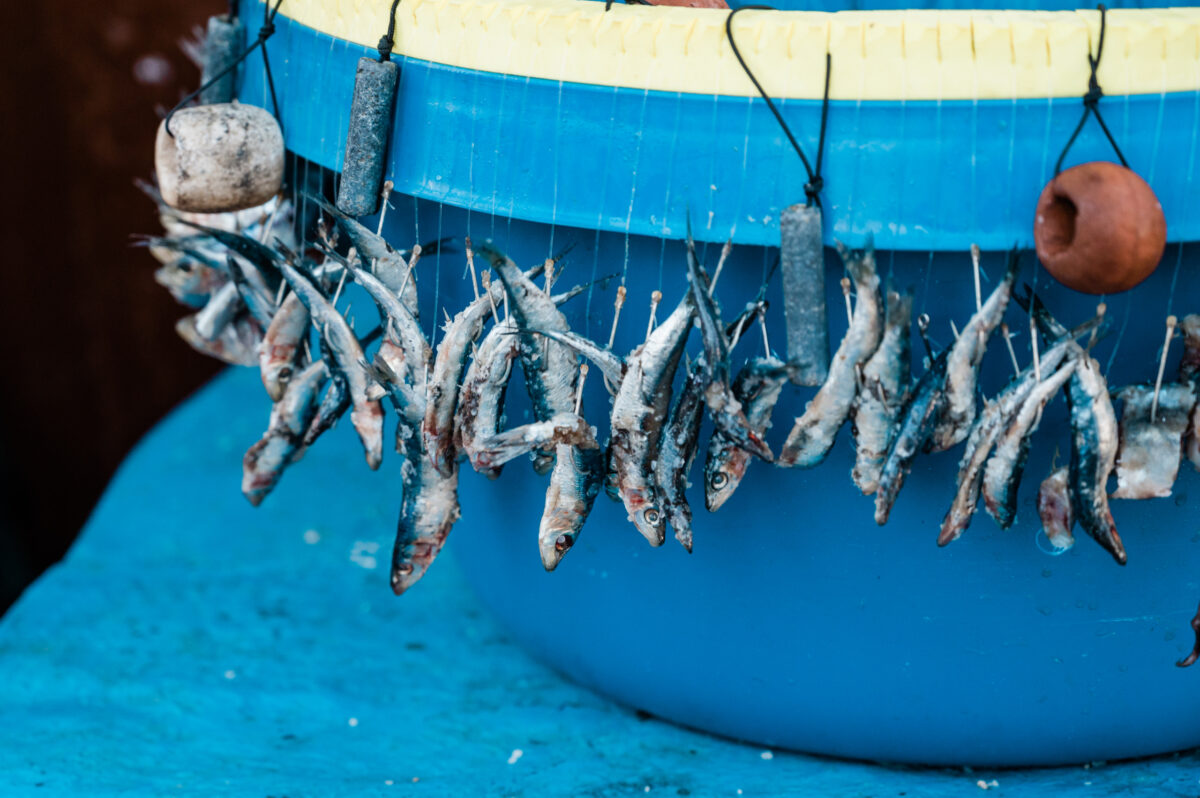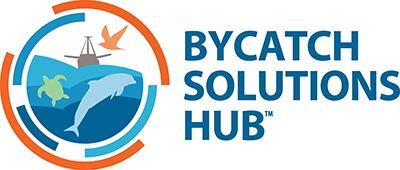Gear Types
Longlines
Longlines can be miles long and contain thousands of baited hooks, leading to high bycatch and mortality rates.
Longlines are long fishing lines or ropes with many hooks, set either in open water (pelagic longlines) or on the ocean floor (benthic longlines). These longlines are composed of a mainline with many shorter lines with baited hooks, often called gangions or snoods, coming off of it. In many fisheries, longlines are many miles long – the average longline in U.S. industrial fisheries is 28 miles long and has thousands of hooks attached to it.
While there is no way to fully prevent ETP bycatch and bycatch mortality in longline fisheries, the adoption of best practices and mitigation gear types can greatly reduce bycatch rates and save wildlife that otherwise would have become hooked or entangled.

Longline hooks baited and ready to be set.
Pelagic longlines are often used to target highly sought open ocean species, mainly tuna, mahi-mahi, swordfish, wahoo, sharks, and other billfish. However, the baited hooks attract many other animals as well, which can get hooked when attempting to eat the bait. Additionally, these lines can be difficult to see in the ocean and, even if they are not attempting to eat the bait, animals can get entangled in the lines, suffer serious injuries, and drown.
Benthic longlines are set on the ocean floor and target demersal species such as cod, snapper, grouper, rockfish, flounders, and toothfish (also called Chilean seabass). While these lines are being set, seabirds and sea turtles often attempt to feed on baited hooks. If they become hooked and are dragged to the bottom of the ocean, they will drown.
ETP Impacts and Fishery Recommendations
- Avoid fishing in hotspot areas that are known to have large abundances of marine mammals.
- Adopt move-on rules (requiring moving to a new location to set) when interactions with marine mammals occur and use fleet communication to inform other vessels.
- Provide best methods handling-and-release training to the captain and crew.
- Require 100% coverage on all fishing vessels – through a combination of human observer and electronic monitoring – with detailed bycatch data collection.
- Ensure 100% compliance with all management measures specific to marine mammals, both at the country and management-organization level.
- Require the use of circle hooks.
- Require the use of fish as bait in place of squid.
- Provide best methods handling-and-release training to the captain and crew.
- Promote deeper sets or night sets in fisheries where it is safe and effective.
- Require 100% coverage on all fishing vessels – through a combination of human observer and electronic monitoring – with detailed bycatch data collection.
- Ensure 100% compliance with all management measures specific to sea turtles, both at the country and management-organization level.
- Require a combination of at least two best practice mitigation methods when setting and retrieving.
- Support the implementation of hook-shielding devices when fishing in regions where high interaction rates with albatrosses and petrels occur.
- Provide best methods handling-and-release training to the captain and crew.
- Require 100% coverage on all fishing vessels – through a combination of human observer and electronic monitoring – with detailed bycatch data collection.
- Ensure 100% compliance with all management measures specific to seabirds, both at the country and management-organization level.
- Require the use of non-steel leaders and non-stainless-steel hooks, so that sharks can break free from the mainline and the hooks will rust and fall out.
- Require the adoption of fins naturally attached rules for fisheries that keep sharks and rays.
- Provide best methods handling-and-release training to the captain and crew.
- Require 100% coverage on all fishing vessels – through a combination of human observer and electronic monitoring – with detailed bycatch data collection.
- Ensure 100% compliance with all management measures specific to sharks and rays, both at the country and management-organization level.
Marine mammals bycatch rates are typically low in longline fisheries, though on occasion small cetaceans can get hooked or entangled when depredating hooked fish. If a marine mammal does get hooked, best handling training can help the crew to quickly dehook and release the animal, increasing its likelihood of survival. Avoiding hotspots with high mammal densities and alerting other crews of these locations can greatly reduce interaction rates.
General Recommendations:
Sea turtles are commonly hooked on pelagic longlines, as they are attracted to the baited hooks. Once hooked, sea turtles will drown if they can’t reach the surface to breathe. This is common in deep-set longline fisheries in the tropics. Even if released alive, sea turtles often swallow hooks, which puncture major organs and can lead to their eventual death.
Existing methods and tools to minimize bycatch and mortality rates for sea turtles have been proven to nearly eliminate sea turtle bycatch when applied as part of a comprehensive strategy.
General Recommendations:
Seabirds attempt to feed on baited hooks when longlines are being set or retrieved, and they can become hooked and severely injured, and often drown. Therefore, the main bycatch reduction goal is to prevent access by seabirds to baited hooks while they are being set, either at the surface or while they are sinking for the first 10 meters. After 10 meters, most seabirds are no longer capable of reaching baited hooks. Any gear that either prevents access to baited hooks (e.g., hook shielding devices, bird scaring/streamer lines), speeds up the sink rate of the hooks (deep setting, weighted gangions), or facilitates setting at night is considered a best practice to mitigate seabird bycatch.
General Recommendations:
In some longline fisheries, up to a quarter of the total catch is shark. While shark species are sometimes an additional target species and are kept and sold by fishers, they are often unwanted bycatch and discarded, typically with high mortality rates. The blue shark is a particularly common bycatch in tuna longline fisheries and has now become a fishery itself.
However, many other bycaught shark species are listed as Vulnerable or Endangered on the IUCN Red List, including mako, thresher, and hammerhead sharks. To mitigate mortality, sharks need to be able to break off when caught, and the crew needs training on how to properly dehook, handle, and release sharks when landed.
General Recommendations:
